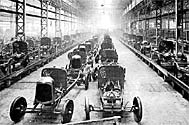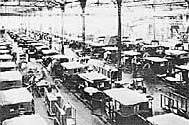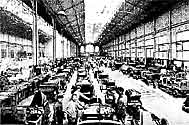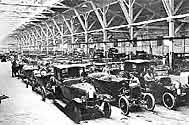|
|
:: [ A brief History of Andre Citroen and of the 5CV Citroen Model C ]
::
(Written
in 2001)
Part 1/. Brief History of
Bozi Mohacek's 1921 Citroen 5CV " L'Escargot "
Part 2/. Andre Citroen and his introduction to double chevron gears.
Part 3/. Andre Citroen and his connection with Mors and Munitions
Part 4/. Formation of the 'S.A. Andre Citroen' Car Company.
Part 5/. Brief History of the Model C 5CV Citroen.
Part 4/. Formation of the 'S.A. Andre
Citroen' Car Company.
One car which seemed to fulfill Citroen's requirements had been the
pre-war small four-cylinder Le Zčbre which had been designed by an army
officer Citroen had got to know in the Army Technical Service, Jules
Salomon. Salomon’s long-term friendship with financier Jacques Bizet
(son of the composer of "Carmen" etc) built up during their
cooperation at George Richard, later Unic, was becoming strained. Citroen persuaded Salomon to leave Le
Zčbre and instructed his
works manger Georges Haardt to commence reorganizing the works for the
production of automobiles.
Jules Salomon produced a design based round a simple four
seater 1327cc sidevalve four cylinder car which Citroen liked. Initially
30 prototypes were built. The car weighed only 990 pounds, was very
economical to run at 35 miles per gallon, and had a top speed of 40
mph. The car was to be called the Type A and was to be provided as
standard with an electric starter, electric lighting, a spare wheel and
a soft top. As these items were normally optional extras, the price at
7,950 FF made the car far cheaper than any of the competition.
Profitability of the venture was to depend on economies of scale, but
for a while the price went up rather than down.
Within four months following the end of the war the Quay de Javel
factory had been converted to automobile manufacture and a new name came
into existence, 'S.A. Andre Citroen'. The Type A was put
into production on the 28th of May 1919 and was launched in April.
A
massive advertising campaign had preceded it with full page
advertisements in newspapers and magazines announcing the launch of
'Europe's first mass production' car. Orders for 16,000 cars were
reported as having been received within a fortnight and the break-even
target of 30,000 was reported as having been reached before any car left
the plant, a powerful use of publicity.
The sales drive was backed with
the introduction of over 1,000 Citroen dealers throughout France fully
conversant with the model being launched and backed with published
repair costs and stocks of spare parts. Owners had access to maintenance
manuals and detailed spare parts catalogues. Buyers were barraged with
posters and advertisements including eventually the lighting up of the
Eiffel Tower with an enormous sign spelling out the name Citroen.
All these publications
resulted in Citroen forming his own publishing company named 'André
Citroën Editions'. Other specialist offshoots followed including
the first finance company in France specifically to finance purchase of
automobiles, and a company specifically set up to provide motor
insurance. In addition Citroen commenced manufacture of model cars
mainly for publicity but this too turned into an industry manufacturing
over 3 million toy cars.
Initially the only body available for the Model A was the open tourer
torpedo, but five body styles followed. Production originally planned as
100 cars per day, grew from an initial 30 cars per day in 1919 and
reached the target of to 100 by the beginning of 1920. By 1921 the
production was up to 20,000, which was more than Peugeot and Renault put
together. A start had also been made in production of flatbed commercial
vehicles. With this many cars behind him, Citroen felt that the basic Model A was ready
for an upgrade and put the Model B into development.
Model B appeared in June 1921 being very similar in concept to the Model
A which had by then reached the production figure of 25,000. Called the
Model B2, it was provided with a 10CV 1450cc engine which made it
marginally faster and like its predecessor it was fully equipped. The
Model A continued in production in small numbers as the 'Sport' until
December 1921. By 1922 the factory was producing over 300 Model Bs a day
and reached some 500 cars a day before the production run ended in 1927.
In the meantime an interesting sideways development was taking place
involving Adolphe Kégresse who had earlier instigated and operated the
Imperial Garage for Czar Nicholas II of Russia between 1909 and 1917.
Kegresse had developed a system of half-tracks which could be fitted to
normal cars to make them suitable for off road and military use. He
teamed up with Citroen and together with Jacques Hinstin (of 'Hinstin
Freres Citroen & Cie') developed a system that was fitted to Model A
and Model B cars.
To publicise the venture some very dramatic
trans-continental half-track expeditions followed. Perhaps the best
known was the 1922 Trans-Sahara Expedition to Timbuktu but other
ventures included the 1924 'La Croisiere Noire' crossing of Africa from
north to south, and 1931 'La Croisiere Jaune' commencing at Beirut in
Lebanon and following Marco Polo's route along the Silk Road to Beijing
in China. A further less well known expedition involved the Subarctic
crossing of British Columbia by Bedaux in 1934.





Continue
with Part 5/.
(Written
in 2001)
Copyright © MMI, Bozi Mohacek. Reproduction only
by permission from the Author.
Go
to Recent Venues Page
|